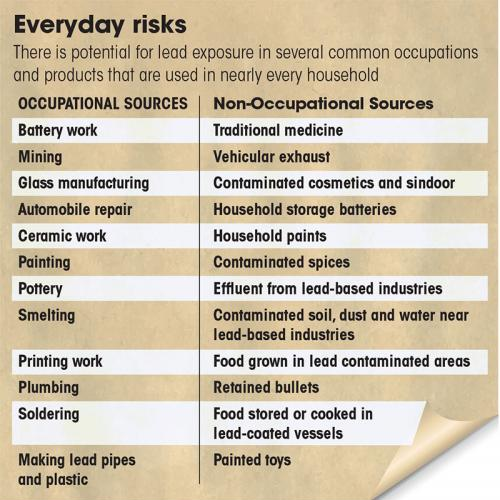Biodiversity & Environment
Lead Poisoning
- 17 Feb 2023
- 6 min read
Prelims: Lead Poisoning, Lead, anaemia, hypertension, renal impairment, United Nations Environment Programme
Mains: Environmental Pollution & Degradation, Lead Poisoning and related concerns
Why in News?
The widespread use of Lead has resulted in extensive environmental contamination, human exposure and significant public health problems in many parts of the world.
What is Lead Poisoning?
- About:
- Lead poisoning is a type of poisoning that occurs when lead accumulates in the body, often over a period of months or years.
- It is caused by the absorption of Lead in the system and is characterised especially by fatigue, abdominal pain, nausea, diarrhoea, loss of appetite, anaemia, a dark line along the gums, and muscle paralysis or weakness of limbs.
- Children are particularly vulnerable to lead poisoning because their bodies are still developing.
- Source:
What are the Implications of Lead Poisoning?
- High Blood Lead Levels:
- According to a 2020 report by the UN Children’s Fund (UNICEF) and Pure Earth, half the children in India report high blood lead levels.
- The report says 275 million children in India record blood lead levels beyond the tolerable limit of 5 µg/dL.
- Of these, 64.3 million children’s blood lead levels exceed 10 µg/dL.
- In terms of average blood lead levels among the population, some 23 states exceed the 5 µg/dL margin; levels in the remaining 13 states and Union Territories cannot be determined as there is a lack of research and screening mechanisms to collect data.
- According to a 2020 report by the UN Children’s Fund (UNICEF) and Pure Earth, half the children in India report high blood lead levels.
- Disability-Adjusted Life Years:
- According to a 2016 analysis by the Institute for Health Metrics and Evaluation (IHME), Lead toxicity in India contributes to 4.6 million Disability-Adjusted Life Years (number of years lost due to disease burden) and 165,000 deaths annually.
- IHME is an independent population health research center at the University of Washington School of Medicine.
- According to a 2016 analysis by the Institute for Health Metrics and Evaluation (IHME), Lead toxicity in India contributes to 4.6 million Disability-Adjusted Life Years (number of years lost due to disease burden) and 165,000 deaths annually.
- Adverse Health Impact:
- Once lead enters the bloodstream, it goes directly to the brain, particularly in children.
- It can be transferred to the foetus during pregnancy, leading to low birth weight and slow growth. Lead poisoning can cause anemia and various illnesses in children and adults, affecting neurological, skeletal, and neuromuscular systems.
What are the Challenges to Cope with Lead Poisoning?
- Less Attention:
- In India, lead does not get as much attention as other potential public health concerns.
- India lacks systems to screen populations for possible exposure. India has some 48 national referral centres for lead projects where blood lead levels can be tested, but screening is usually done on a voluntary basis or at health camps by non-profits.
- Poor Recycling Laws:
- Many developing countries, including India and under-developing countries have a lack of stringent laws over informal recycling sectors.
- As a result, enormous quantities of (lead)-acid batteries are recovered without using scientific techniques in an unregulated and uncontrolled way.
- Management of lead-acid batteries came under the Batteries (Management and Handling) Rules, 2001. But enforcement capacity to ensure safe and environmentally sound recycling has been inadequate.
- In 2022, The government notified the Battery Waste Management Rules, 2022, but it remains to be seen whether the government can successfully implement this.
- High demand for Cheap Products:
- Many low-cost products in India contain lead, and people may not be willing or able to pay more for lead-free alternatives.
Way Forward
- Regular screening and testing of lead sources will inform about region-wise prevalence and help tailor interventions, such as “regulations and enforcement, changes in industry practices, training of government officials to assess lead contamination, and changes in public education and consumer behaviour.
- As recycling of used lead-acid batteries risks exposure, discouraging informal operations and regulating the sector will help.
- India must enhance capacity for testing, currently done for blood lead levels, and the government should create facilities for blood lead level screenings at every district hospital.
- Lead poisoning needs to be a part of the narrative of India’s health status.
- There is a need to devise strategies on a state level, through regional bureaucracy, local press and vernacular language to have tangible impact.
UPSC Civil Services Examination, Previous Year Questions (PYQs)
Q. Lead, ingested or inhaled, is a health hazard. After the addition of lead to petrol has been banned, what still are the sources of lead poisoning? (2012)
- Smelting units
- Pens and pencils
- Paints
- Hair oils and cosmetics
Select the correct answer using the codes given below:
(a) 1, 2 and 3 only
(b) 1 and 3 only
(c) 2 and 4 only
(d) 1, 2, 3 and 4
Ans: (b)





